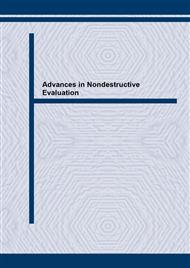[1]
H. K. Lee, K. M. Lee, and Y. H. Kim, Comparison of longitudinal wave velocity in concrete by ultrasonic pulse velocity method and impact-echo method, J. Korean Soc. Nondestructive Testing, Vol. 23 (2003), pp.98-106.
Google Scholar
[2]
American Society for Testing and Materials, Test for Pulse Velocity Through Concrete, ASTM-C-597, (1991).
Google Scholar
[3]
British Standards, Measurement of Velocity of Ultrasonic Pulses in Concrete, BS 1881, Pt. 203, U.K. (1986).
Google Scholar
[4]
P. K. Mehta and P. J. M. Monteiro: Concrete (Prentice Hall, Second Edition, 1993).
Google Scholar
[5]
A. M. Neville: Properties of Concrete (Longman, 1995).
Google Scholar
[6]
V. R. Strrup, F. J. Vecchio, and H. Caratin, Pulse velocity as a measure of concrete compressive strength, In-Situ-Nondestructive Testing of Concrete, SP-82, ACI, Detroit, (1984), pp.201-227.
Google Scholar
[7]
S. Pessiki and M.R. Johnson, Nondestructive evaluation of early-age concrete strength in plate structures by the impact-echo method, ACI Materials Journal, Vol. 52(1986), pp.297-302.
DOI: 10.14359/9811
Google Scholar
[8]
S. Popovics, Analysis of the concrete strength versus ultrasonic pulse velocity relationship, Materials Evaluation, (2001), No. 2, pp.123-130.
Google Scholar


